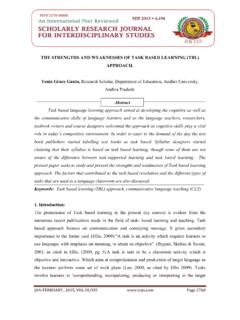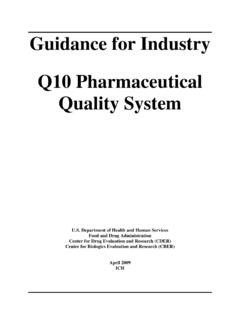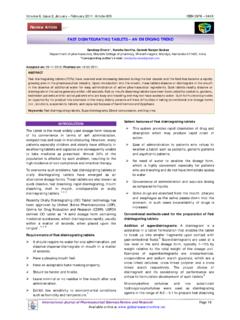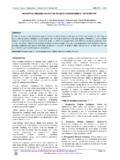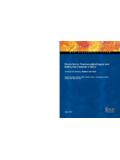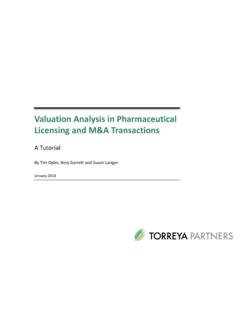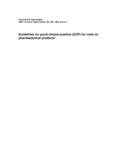Transcription of Development and Validation of Related Substances …
1 Available online at Journal of pharmaceutical Sciences and Drug research 2012; 4(1): 63-6963 research ArticleISSN 0975-248 XDevelopment and Validation of Related Substances Method by HPLC for Analysis of Naproxen in Naproxen Tablet FormulationsPakhuri Mehta1*, Chandra Shekhar Sharma1, Deepak Nikam2, M. S. Ranawat11 Department of pharmaceutical Chemistry, B. N. College of Pharmacy, Udaipur, Rajasthan, India2 Institute of Science, Mumbai (Maharashtra), IndiaABSTRACTA simple, selective, rapid, precise and isocratic reversed phase high-pressure liquid chromatography method has been developed and validated for estimation of Related Substances of Naproxen in pharmaceutical dosage form.
2 It was performed on a YMC-ODS A Pack (5 particles size) (250mm ) column using mobile phase containing Acetonitrile and 10 mM Ammonium acetate buffer pH in ratio 550:450 v/v (pH adjusted with acetic acid) at the flow rate ml/min. Detection was performed at 254 nm and a sharp peak was obtained for Naproxen at a retention time at about min. Linear regression analysis data for the calibration plot showed there was a good linear relationship between response and concentration in the range g/ml; the regression coefficient was The detection (LOD) and quantification (LOQ) limits were and g/ml respectively.
3 The method was validated for accuracy, precision, specificity, robustness, and detection and quantification limits, in accordance with ICH guidelines. Statistical analysis proved the method was precise, reproducible, selective, specific, and accurate for analysis of Naproxen and its impurities. The wide linearity range, sensitivity, accuracy, short retention time, and simple mobile phase showed that the method is suitable for routine quantification of impurities in Naproxen in pharmaceutical dosage forms with high precision and :Naproxen, RP-HPLC, YMC-ODS A, [(+)-2-(6-methoxy-2-naphthyl) propionic acid or (NAP), is a non-steroidal anti-inflammatory drug with anti-inflammatory, analgesic and antipyretic properties often preferred to acetylsalicylic acid (aspirin) because of its better absorption following oral administration and fewer adverse effects.]
4 Anti-inflammatory effects of naproxen are generally thought to be Related to its inhibition of cyclo-oxygenase and consequent decrease in prostaglandin concentrations in various fluids and tissues. [1]Formulated in tablets or suppositories, it is used in the treatment of rheumatoid arthritis and other rheumatic or musculoskeletal disorders, dysmenorrhea and acute gout. Naproxen in commercial formulations has been determined by coulometry [2], UV spectrophotometry [3-6], heavy atom-induced room temperature phosphorescence [7]and high-performance liquid chromatography (HPLC).[8-13]There was no HPLC Related Substances method specified for Naproxen API and tablet formulations in United States Pharmacopoeia.
5 Hence, there was a need to develop it which became the purpose of the further study. [14]*Corresponding author: Mrs. Pakhuri Mehta, Department of pharmaceutical Chemistry, B. N. College of Pharmacy, Udaipur, Rajasthan, India;Tel.:+91-9460082770;Fax: +91-294-2413013;E-mail: work describes the Development of simple, selective, rapid, accurate and precise RP-HPLC method for the determination of Related Substances of Naproxen in pharmaceutical dosage 1: Structure of NaproxenEXPERIMENTALA pparatus and chromatographic conditionChromatographic separation was performed on an Agilent 1100 Series HPLC system.
6 YMC-ODS A Pack (5 particles size) (250 mm mm) column was used for separation. Analysis was performed at ambient gift sample of Naproxen and impurities were provided by Sandoz Pvt. Ltd., Mumbai. Tablet formulations of Naproxen (500 mg) (Brand: Naprosyn) were procured from a local pharmacy. All the chemicals and reagents used were of analytical grade. High-purity water available from Millipore purification system was DevelopmentMehtaet Development and Validation of Related Substances Method by HPLC for January-March, 2012, Vol 4, Issue 1 (63-69)64A detailed literature search was conducted to check theavailable methods for quantification of Naproxen impurities in tablet formulation and very few information was available.
7 Hence, it is decided to start the method Development using reversed phase chromatography; as reversed phase chromatography is most commonly used and ample columns are available for reversed phase chromatography. Further, considering the pKa of Naproxen , decided to select mobile phase pH range near to pKa. Based on this information, selected mobile phases were investigated in the Development of an HPLC method suitable for analysis of Naproxen tablet formulation. These included Acetonitrile-Water-Acetic Acid, 550:450:1(v/v), Acetonitrile-Water-Orthophosphoric acid (pH adjusted with triethylamine) 550:450:1(v/v) and Acetonitrile: 10mM Ammonium acetate buffer (pH adjusted with acetic acid) 550:450(v/v).
8 The suitability of the mobile phase was decided on the basis of the sensitivity of the method, suitability for stability studies, time required for the analysis, ease of preparation and use of readily available solvents. Mobile phase were premixed and filtered through a m nylon filter and degassed. Optimization and finalization of mobile phase was also done based on observations for various parameters such as retention time, theoretical plates and resolution. Acetonitrile Water 50:50(v/v) was used as the : Five tablets (each tablet containing 500 mg Naproxen) of Naproxen were weighed accurately.
9 The tablets were finely powdered and powder equivalent to 250 mg of Naproxen was taken in a 500 ml volumetric flask and then dissolved in 250 ml of diluent. The powder mixture was dissolved in the diluent with aid of sonication for 15 min with occasional swirling and then diluted up to the mark with diluent. After setting the chromatographic conditions and stabilizing the instrument to obtain a steady base line, the tablet sample solution was filtered through m Nylon filter after discarding first 2 ml. The solution was injected into the chromatographic system and chromatogram was Validation [15-16]LinearityStandard stock drug solution of Naproxen with concentration of 125 g/ml was prepared in diluent.
10 For preparation of calibration curve of drug 1, , 5, 10, 12 ml of standard stock solution of Naproxen were transferred to series of 500 ml volumetric flasks and volume was made up to the mark with the diluent. Each solution was injected after filtration through m membrane filter and chromatograms were recorded at 254 nm. The prepared dilutions were injected in series, peak area was calculated for each dilution, and concentration was plotted against peak area. Determination of Response FactorThe response factor for all impurities with respect to Naproxen was evaluated at 3 concentration levels.




